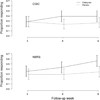Time to Response to Citalopram Treatment for Agitation in Alzheimer Disease
- PMID: 26238225
- PMCID: PMC4653092
- DOI: 10.1016/j.jagp.2015.05.006
Time to Response to Citalopram Treatment for Agitation in Alzheimer Disease
Abstract
Objective: Agitation is a common and significant problem in Alzheimer disease (AD). In the recent Citalopram for Agitation in Alzheimer's Disease (CitAD) study, citalopram was efficacious for the treatment of AD agitation. Here we examined the time course and predictors of response to treatment.
Methods: Response in CitAD was defined as a modified Alzheimer Disease Cooperative Study Clinical Global Impression of Change (CGIC) score of 1 or 2 or a Neurobehavioral Rating Scale agitation subscale (NBRS-A) score reduction ≥ 50% from baseline. "Stable early response" was defined as meeting the aforementioned criteria at both weeks 3 and 9, "late response" was response at week 9 but not at week 3, and "unstable response" was response at week 3 but not at week 9.
Results: In the primary analyses, citalopram was superior to placebo on both the CGIC and the NBRS-A response measures. Little between-group differences were found in response rates in the first 3 weeks of the study (21% versus 19% on the CGIC). Citalopram patients were more likely than placebo patients to be a late responder (18% versus 8% on CGIC, Fisher's exact p = 0.09; 31% versus 15% on NBRS-A, Fisher's exact p = 0.02). Approximately half of citalopram responders (45%-56%) at end of study achieved response later in the study compared with 30%-44% of placebo responders.
Conclusion: Treatment with citalopram for agitation in AD needs to be at least 9 weeks in duration to allow sufficient time for full response. Study duration is an important factor to consider in the design of clinical trials for agitation in AD.
Keywords: Agitation; Alzheimer disease; citalopram.
Copyright © 2015 American Association for Geriatric Psychiatry. Published by Elsevier Inc. All rights reserved.
Figures
References
-
- Schneider LS, Tariot PN, Dagerman KS, Davis SM, Hsiao JK, Ismail MS, et al. Effectiveness of atypical antipsychotic drugs in patients with Alzheimer's disease. N Engl J Med. 2006;355:1525–1538. PMCID: PMC17035647. - PubMed
-
- Schneider LS, Dagerman KS, Insel P. Risk of death with atypical antipsychotic drug treatment for dementia: meta-analysis of randomized placebo-controlled trials. Journal of the American Medical Association. 2005;294:1934–1943. - PubMed
-
- National Collaborating Centre for Mental Health. The treatment and management of depression in adults. London (UK): National Institute for Health and Clinical Excellence (NICE); 2009. Depression.
Publication types
MeSH terms
Substances
Grants and funding
LinkOut - more resources
Full Text Sources
Other Literature Sources
Medical


